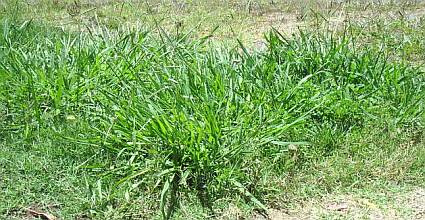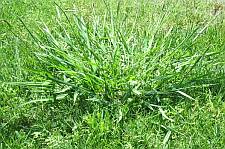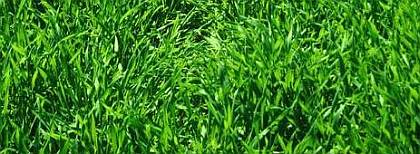HOW TO KILL CRABGRASS
Kill Crabgrass Now!
Don’t delay, but don't make a mistake.
The innocent looking, attractive green seedlings quickly become voracious monsters that can devour your entire lawn.
What will it cost in terms of time, energy and money to get rid of this nuisance? Unfortunately, this is one of the worst weeds to get rid of.
How bad is your infestation? How big is your lawn area? Are other garden areas affected?
Learn what options you have before you embark on this process.
Like many other pest problems, you’ll have to fight more than one battle to win this war.
Take a quick look at these ideas, then get to work!
We’ll start with lawns, since this is the most common problem area. Other articles are available to assist with crabgrass prevention.
First, are you certain that it's crabgrass? If so, proceed.
If not, take a look at the Crabgrass Pictures photo gallery.
And now, it’s time to fight!
FTC Disclosure:
If you make a purchase via a link on this site, I may receive a small commission on the transaction - at no added cost to you.
Sponsored Links

THE FAST WAY TO KILL
CRABGRASS IN LAWNS
The fast way, (compared to pulling out crab grass by hand), is to spray it with a weed killer. Some products work faster than others. They all require study, preparation and proper application, hence this
WARNING:
The fast way to kill crab grass could also
be a fast way to kill your good lawn grass.
Many lawns will tolerate a chemical spray designed to kill crabgrass, but not all grass varieties are safe. Many different manufacturers of garden chemicals offer their own version of crabgrass killer.
Previously, the most common variety of chemical was MSMA, or monosodium-acid-methane-arsonate. Some companies had other versions of methane-arsonate, such as DSMA or CAMA. These are now prohibited and I offer info about this at the bottom of the page.
PRODUCTS TO KILL CRABGRASS
Quinclorac 75 DF Selective Herbicide is a common chemical in many retail crabgrass & weed killing products. It is often combined with other chemicals to also kill other types of weeds. It can now be purchased as a concentrate, to concentrate on the crabgrass.
It is a systemic product that translocates throughout the plant to kill roots and all, but it needs time to take effect.
Initially, negative product reviews on popular websites were discouraging, but I suspect user error caused a high percentage of disappointed homeowners or their expectations were for a quick kill.
This is not your average "grab off the shelf from the local box store" product that you hook up the garden hose to a bottle and spray.
Quinclorac 75 DF is a wettable powder, and Quinclorac 1.5L is a liquid formulation that is reported to higher quality results than the dry form. Both must be mixed with water in a sprayer and applied correctly.
See the details for various sizes and options/combinations of Quinclorac at DoMyOwn Pest Control
Look for the PDF Label and/or Supplemental Label on the individual product pages and read them!
Sponsored Links

TENACITY is a recent addition to the weed killer arsenal. It holds great promise for many applications including diverse lawn types and for getting rid of the toughest (most tenacious!) lawn weeds.
Before considering it, watch the videos and read the information about its application, particularly the use of an adjuvant and the importance of watering adequately after applying.
See the details at Tenacity Turf Herbicide from DoMyOwn Pest Control.
Also, look for the PDF Label and Supplemental Label on the product page and read them!
But don't rush to buy one of those until you know it is the right stuff! Does that sound too demanding or confusing?
How important is this?
It is VERY IMPORTANT to read the label on Crabgrass Killer!
Why?
Crabgrass killer will kill some varieties of grass lawns, under any conditions.
It will kill other varieties if used incorrectly.
To borrow a famous phrase: It will kill some of the grass all of the time, and all of the grass some of the time!
As an example, I have another article on St. Augustine lawns and centipede grass that tells how they are particularly susceptible to most crabgrass killers. They are likely to suffer injury, and may be killed. Some products may permit their use on these grasses at lower concentrations, others say not at all.
Bermuda, zoysia and bent grass may be fine for applications of crabgrass killer, but not at all times of the year. Fescues and ryegrass may be alright with some products, or some concentrations, but not all.
Please read the label before you buy,
Read it again, before you apply!
APPLICATION:
You can successfully kill crabgrass in some lawns with products designed for that purpose. This should be marked clearly on the label. Ready-to-Use hand trigger bottles for spot treatments/small areas and hose-end attachments for larger areas are more expensive per application.
Weed killers are also available as concentrates that can be mixed in a tank sprayer. Use no more than the recommended amount.
It is always better to do a repeat application than to use a stronger mix, thinking it will work better or faster.
NEED TO KNOW
Do not use these concentrates in your hose end sprayer unless it is the type that allows you to dial in the setting for the correct concentration. The liquid fertilizer sprayers may not permit this.
Some spot treatment products may not be designed for use in a lawn.
If the label says “non-selective”, it will kill anything it contacts.
You want to use a “selective” killer intended to specifically kill crabgrass in a lawn.
If the crabgrass you are spraying is young, it may die after one treatment.
More mature weeds may require one or two repeat applications. Follow the interval schedule on the label for the repeat time.
RULES
- Don’t mow the lawn prior to applying the chemical, since you want more leaf area of the weed to soak up the spray.
- Don’t water after spraying for 24 hours, and if rain is forecast, it may be better to wait and apply the treatment after the storm.
- Don't ruin your spray equipment. Thoroughly rinse the container immediately after use. Avoid leaving residue that could clog the unit or affect other plants later.
- Don’t mix more product than you will use in one application. Potency can diminish if the mix sits for days before it is used.
BIG CAUTION:
HOT WEATHER!
Trying to kill crabgrass in your lawn when the weather is extremely hot will place additional stress on your good grass.
If you spray when the temperature is over 85 degrees, the lawn can incur more damage than if you spray when it is cooler.
It is best to wait for a cooler spell, if possible. If that is not likely to happen, then spray very early in the morning or later in the evening, avoiding the hottest part of the day
AFTER-EFFECTS:
It is not uncommon for a lawn to show discoloring after being sprayed with chemicals for killing crabgrass. This should not be a cause for concern, if you used the appropriate dosage.
If you see yellowing of your lawn, just be patient, and the lawn should grow out to its normal color within one or two mowings.
With the Tenacity product, only the affected weeds stop producing chlorophyll and start to turn white as they die.

Using Other Weed Killers To Kill Crabgrass
Many homeowner like to use a weed and feed fertilizer. These products are designed as a convenience to help control broadleaf weeds in your lawn, while you fertilize. They will not kill crabgrass.
Broadleaf weeds and grassy weeds are completely different types of plants. Different chemicals have been designed for each group. Always use a product intended for your purpose.
If you find a granular weed and feed that specifies it will kill crabgrass, use it if you have a minor problem. Realize however, that the granules have to land and stay on the weed to be absorbed. This means many crabgrass plants could be missed. A liquid spray allows you to cover the weeds more thoroughly.
Weed killers like Round-Up that are All-Purpose killers are able to kill crabgrass, but they will also kill your lawn. Use these non-selective killers only in places where you can avoid spraying them on desirable plants.
Natural or organic products may be available in your area. These are often derived from plant oils, sometimes they are salt-based products. Even vinegar, at full strength, can kill crabgrass and other weeds. Typically these will be non-selective, and will also cause damage to your lawn.
(Vinegar at a normal household concentration of 5% is not strong enough to kill crabgrass with one application. Read more at
Vinegar, the Weed Killer.)
Another natural method to kill crabgrass is to pour boiling water on the weed. This usually kills any weed. It also usually kills everything. A creeping grass like Bermuda or St. Augustine may recover from such a treatment, but test it on a small area first if you are inclined to try it.
A Last Resort?

When crabgrass has grown to the point of forming a dense mat or clump, it may have smothered your good lawn grass. If this is the case, you will have to reseed the area. In this situation, it may be acceptable to use a Non-Selective weed killer, since the crabgrass is a worse problem than losing a bit more grass.
TIP: If the crabgrass clumps in your yard are somewhat isolated from each other, make a spray barrier. Use an open-bottom cardboard box or roll a sheet of cardboard into a large tube. Confine your spraying within this perimeter, and spray when there is no wind. This may reduce the sideline damage to the surrounding lawn.
The Slow Way To Kill Crabgrass In Lawns
Put on a pair of gloves. Grab a serrated knife or a V-shaped weeding tool. Slice into the root of the crabgrass. Pull up the weed and discard. Repeat.
No fun? But all kidding aside, sometimes that is not a bad approach. You might be surprised what you can accomplish by taking 15 or 20 minutes each evening. Start on one side and methodically work your way across the yard. You can cover a good size area each week this way.
Enlist the help of a family member and have a nice conversation outside each evening as the air cools. Kids can be surprisingly effective at this when they are helping you, and not being ordered to do it by themselves. Just think, you get less exposure to chemical or TV pollution, while you kill crabgrass for free, plus the bonding!
As a side-note, related to the chemical element, you should be aware that MSMA is an arsenic based product, and it does leave residue in the soil. This may be a cause of concern for some individuals or situations, enough to make the idea of yard "work" seem more attractive.
Kill Crabgrass In Other Areas
Crabgrass in ornamental groundcovers and flowerbeds can be accomplished with certain selective chemicals that target all grassy weeds.
Ornamec is a very effective, selective grass killer that is safe to use around most shrubs, trees and ground covers. Check their extensive list on the label to be sure your desired plants are considered to be safe.
You may be able to kill crabgrass plants that are young with only one application. Older plants may take 2 or 3 shots. Ornamec is an expensive product, but worth it. A small amount of concentrate covers a large area when mixed.
Take note, the ad to the right is for the OTT version, the strongest concentration, at 6.75% active ingredient. This is the best value for those with a large area to cover.
For smaller projects, or for those who want to try it out at a cheaper price, use this link for Ornamec 170, which is a "lite" version at 1.70% concentration:
The mixing ratio is very different for those two versions, so always read the label for the correct dosage.
Be sure to mix it with the surfactant that is included, to get the best absorption of the chemical.
Read my Ornamec Grass Killer article about killing bermuda grass in lawns to understand more about the product.
Another choice applies only to succulent ground covers, like ice plant. Magnesium chloride, a salt compound is effective at killing both grassy and broadleaf weeds in ice plant. It burns the weeds but the ice plant has sufficient water reserves to be protected.
No water can be applied for 5 days or the weeds may recover. “Killer - Ice Plant Weeder” is one version of this, available in some areas. It is not very concentrated. The mixing ratio is only 1 to 1.
NOTE: for ice plant ground cover only, not to be used on regular plants!
Winning The Crabgrass War
The key factors in being able to successfully kill crabgrass are worth summarizing:
- Start early. Killing young plants is easier with less potential harm to lawns and desirable plants.
- Kill crabgrass before it goes to seed to avoid next year’s war.
- Stay alert. New crabgrass plants can start throughout the warm growing season.
- Follow label directions accurately to prevent bad results.Be persistent and be patient. Try to kill crabgrass at least partially during the warm season, then prevent its return.
- Know your enemy. Read the article Getting Rid Of Crab Grass for more tips on dealing with this problem on all fronts.
- This article has focused on how to kill crabgrass that is already growing. Crabgrass prevention is an important strategy for long term effectiveness. Read about this technique in the article When To Apply Crabgrass Preventer.
Go to Crabgrass general information page
Go to Getting Rid Of Crab Grass
Go to Crab Grass Killer for St. Augustine Grass
Go to Home Page of Lawn Care

BRING ON SPRING!
A Stronger, Greener Lawn
Starts Now...
with help from DoMyOwn
Products * Videos * Schedules * Guides
FOOTNOTE ON MSMA
{Editor's Update: MSMA, once very common, has become a dinosaur in the herbicide field; it is restricted or prohibited in most areas. Officially, where still available, it is intended to be sold only to licensed applicators, and is labeled for specific non-turf uses. It is no longer proper to use it on a residential lawn.}
HOWEVER, it is possible for homeowners to purchase certain chemical herbicides through on-line sources. Some of these products would not be available through local distribution retailers, often because the purchaser is required to be a Certified Applicator or have a valid Pesticide License.
The fact that you can access some weed killers does not automatically make it safe or proper for the general public to use it, randomly or indiscriminately.
Some will say, "MSMA is not that bad, and is the only thing that works." Read the following info, use good judgment, and consider if it is worth any risk. I recommend the newer alternatives to MSMA.
"The Turfgrass Industry Officially Loses MSMA" by J. T. Brosnan, G. K. Breeden & A. J. Patton
EXCERPT: MSMA, an organic arsenical herbicide, contains an organic form of the element arsenic. In its organic form, arsenic is relatively nontoxic. For example, the herbicide MSMA is far less toxic than aspirin. However, in an inorganic state, arsenic can be highly toxic. It is important to note that MSMA only contains organic arsenic. Further more, research has continually shown that MSMA is tightly bound to soil organic matter and is not readily leached.
However, water samples from two golf courses in Florida tested high in arsenic in 2006. This spurred a ruling by the United States Environmental Protection Agency (EPA) to cancel the registration of MSMA in all aspects of agriculture, including turfgrass management. There was a concern that organic arsenic from MSMA could convert into the more toxic, inorganic form in the environment.
SOURCE: http://www.uaex.edu/publications/PDF/FSA-6145.pdf
Related to this, here is an article from the Environmental Protection Agency which made the ruling on MSMA:
"Organic Arsenicals" (Current as of April 2013)
EXCERPT:
Exposure from Treated Residential Lawns
Short-term use of organic arsenical products used according to label directions does not present an imminent risk. The Agency’s primary concern is for these products to transform over time to the more toxic inorganic form of arsenic in soil and subsequently be transported to sources of drinking water. This issue is being addressed through new label restrictions. Because this transformation occurs beneath the soil surface, long-term residential exposure to inorganic arsenic in soil is unlikely. To further minimize potential exposure on lawns, keep children and pets off treated areas.
Safe Use and Disposal of Homeowner Products
It remains legal to purchase and use organic arsenical herbicides according to label directions and precautions. Use of these products according to label directions does not pose an imminent hazard. EPA has initiated action to address the potential for these chemicals to transform over time and contaminate sources of drinking water. Consumers who choose to use these products should take special care to always read and follow the label precautions and directions.
SOURCE:
http://www.epa.gov/pesticides/reregistration2/organic_arsenicals_fs.html